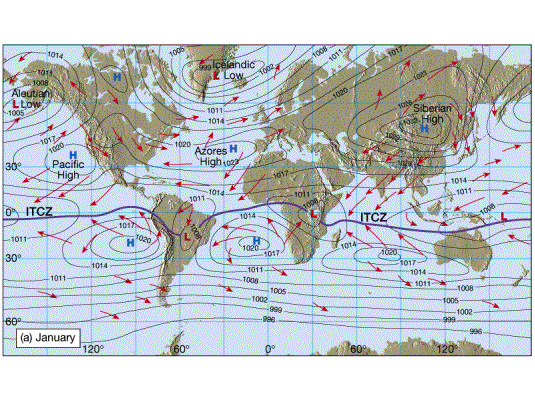1. Located in both the northern and eastern hemispheres, the
nation of Russia lies within the latitude and longitude of 60° 0’0” N/ 100°
0’0” E. Russia lies within the Polar and Ferrel atmospheric cells. Due to its
location, we can generally estimate that Russia experiences Westerlies
(westerly winds), while its northernmost region lies near the Subpolar Low.
Russia lies over the Subtropical High Pressure Belt.
However, since the nation is of such an immense size, the weather can be
extremely variable. Russia is bordered along the north by the Arctic Ocean,
therefore its weather is deeply affected by the Polar easterlies and the
Subpolar Low. Russia also lies near the northern Horse Latitudes.
2. The Siberian High, or Siberian Anticyclone, is a large
mass of cold, dry air that lies on the northeastern region of the Europe-Asia
border for the coldest part of the year. This period of time usually runs from
September through April.
The Siberian High in centered in Lake Baikal, Russia. The
pressure system reaches its maximum strength in the winter, and has reached the
coldest recorded temperature in the Northern Hemisphere at -90°F (located in
Russia). The coldest temperature in the northern contiguous U.S. states is a
direct result of the Siberian High moving southward over North America. During
the summer months, warmth over the Asian landmass results in the breakdown of
the pressure system.
3. The Ural Mountains form the natural division between
Europe and Asia, extending roughly 1,300 miles. The highest peak is 6,214 feet.
The Sayan and Stanovoy mountains ranges lies west of Lake Baikal, centrally
located in the Siberian Anticyclone. The Caucasus Mountains are the only
forested region of topography in the nation, and are host to Europe’s highest
peak, Mt. Elbrus (18,510 feet). Winds and breezes that are associated with
mountains include valley and mountain breezes, Chinook, Katabatic, and Santa
Ana Winds. A buran is a strong, cold wind that dominates Russia and Central
Asia. Russia is not subject to coastal winds or breezes.

No comments:
Post a Comment